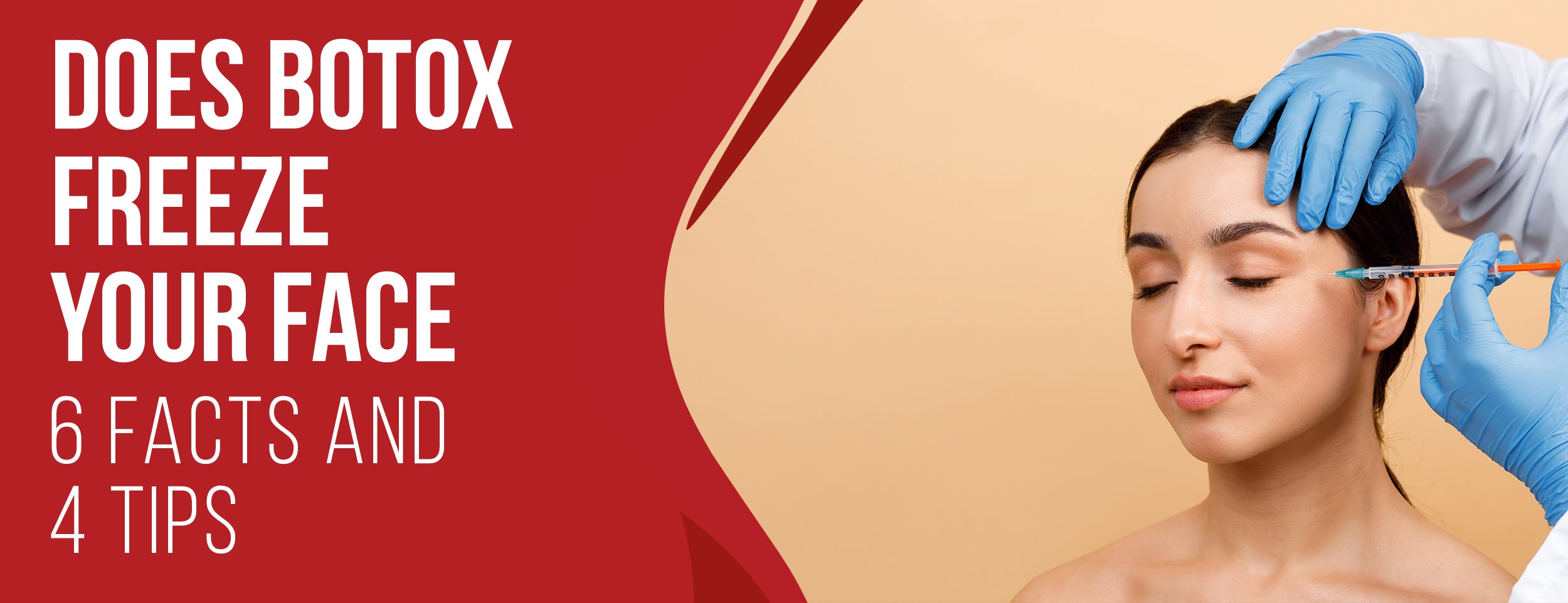Botox must first bind to a specific location on the muscle called the motor endplate. This process can take around 20 minutes after injection, during which the Botox is slowly diffusing into the muscle fibers.
An injection location, the dose, and the metabolism determine how long Botox stays in muscles. Botox injections generally last between three and six months, after which the muscles gradually return to their normal function, and the wrinkles reappear.
The time frame can also vary depending on factors like the thickness of your skin and the strength of your muscles. With repeated treatments, Botox can train muscles to contract less, thereby prolonging the effects and reducing the frequency of injections needed.
In this blog post, we'll explore more about how Botox specifically affects muscle strength and what you can expect during and after your treatment.
How Long Does It Take Botox To Bind To Muscle: 3 Stages

Botox typically takes 2 to 4 days to bind effectively to muscle receptors, initiating muscle relaxation and reducing movement. Maximum visible results are usually observed between 10 to 14 days after the injection.
Initial Muscle Weakening (2-4 Days)
After receiving a Botox injection, the neurotoxin typically takes two to four days to weaken the targeted muscle. During this period, you may notice a gradual reduction in muscle activity, leading to a smoother appearance in the treated area.
Maximum Results (10-14 Days)
While you may start to see some effects within a few days, the maximum results of your Botox treatment typically become evident between ten to fourteen days after the injection. During this time, the neurotoxin fully binds to the muscle receptors, effectively reducing muscle contractions and smoothing wrinkles or lines.
Extended Benefits (Up to 3 Months)
One of the remarkable aspects of Botox treatment is its longevity. Even though you'll notice the full effects by the two-week mark, these results can last up to three months. This extended period of muscle relaxation means you can enjoy the benefits of your Botox treatment for an extended duration before considering a follow-up appointment if desired.

Time Frame of Botox Injection for Maximum Results
When undergoing Botox cosmetic treatment, it is crucial to understand what to expect after injection clearly. Patients often wonder about how long it will take for the cosmetic results to appear and how long they will last. It is important to note that Botox does not provide immediate results. There is typically a delay between injection and seeing maximum effects, which can vary depending on several factors.
Visible Changes:
Botox binds to a precise junction where muscles and nerves intersect, known as the motor endplate. The initial delay of two to four days is attributed to the time it takes for Botox to establish a strong binding at this critical point. During this period, the neurotoxin begins to exert its effect on the muscle's ability to receive nerve signals, initiating the process of muscle relaxation.
Peak Performance:
The gradual approach to achieving maximum results is a fundamental aspect of Botox treatment. Even though some subtle changes might be noticeable within the first 3 or 4 days, the significant reduction in muscle activity and the resulting smoothing of wrinkles evolve. Ten to fourteen days after treatment, the symptoms of progressive muscle weakness are most noticeable.
Effects of Thicker Skin and Stronger Muscles
Botox injections have been found to weaken muscles and thicken the surrounding skin, affecting the overall aesthetic results. Gender and individual anatomical variations can influence the process.
Thicker Skin Consideration:

Men, often possessing thicker skin and robust facial muscles, might require a higher Botox dose to attain the desired cosmetic effect. The increased muscle mass and tissue density can necessitate an adjustment in the dosage to ensure effective muscle relaxation and wrinkle reduction.
Muscle Strength Impact:
Men typically have higher levels of testosterone, a hormone that can influence the longevity of Botox effects. The heightened hormonal level in men might cause Botox to wear off slightly faster than in women, necessitating potential follow-up treatments sooner.
Shallow Wrinkles First To Show Significant Improvement
It is most effective for shallow wrinkles, such as crow's feet and forehead lines, and shows significant results after just one session. When it comes to Botox's effects, not all wrinkles are created equal.

Shallow Wrinkles' Advantage:
Shallow wrinkles, such as those on the forehead or frown lines, respond promptly to Botox treatment. They are often the initial areas where noticeable improvement becomes evident.
Dynamic Expression Lines:
As Botox takes effect, the skin surrounding shallow wrinkles may feel slightly tighter. Notably, when making exaggerated facial expressions, the impact of the treatment becomes apparent, with the treated areas responding with reduced movement and smoother skin texture.
Factors that Affect Botox Muscle Binding
Several factors contribute significantly to Botox's ability to bind to muscle when considering its binding timeline. This information can provide valuable insight into individual response times. Here are some key considerations:
Genetic And Personal Factors

It can take Botox a long time to bind to muscles based on genetics and personal characteristics. Muscle binding rates can vary depending on genetics and physiological attributes. Consider these factors:
- Metabolism: The speed at which one's body metabolizes substances, including Botox, can influence the binding process.
- Muscle Density: Variations in muscle density can affect the dispersion and interaction of Botox within the muscle fibers.
- Neuromuscular Junction Efficiency: Genetic differences in the neuromuscular junction, where nerve signals communicate with muscles, can influence the efficiency of Botox binding.
Dosage And Concentration
Botox dosage and concentration are critical determinants of binding time in a treatment session. A medical professional carefully calibrates these factors while considering the following aspects:
- Dosage: The amount of Botox administered can impact how rapidly the muscle-binding process takes place.
- Concentration: The strength of the Botox solution plays a role in how effectively it binds to muscle receptors.

Application Site And Injector Technique
The precise location of Botox injections and the injector's technique affect muscle binding. Techniques and sites involved in the application include:
- Injection Site Significance: Botox can be injected intradermally to target oil glands, sweat glands, and arrector pili muscles on the skin's surface.
- Intramuscular Technique: For addressing wrinkles and muscle stiffness, Botox is injected intramuscularly, reaching deeper layers of muscle tissue.
- Intradermal Injections: Precision in targeting specific skin structures is achieved through intradermal injections, addressing localized concerns.
- Intramuscular Injections: Effective treatment of wrinkles and muscle issues relies on intramuscular injections, ensuring the neurotoxin reaches the intended muscles for desired outcomes.
Individual Variability In Botox Response
Each individual's response to Botox is inherently unique. Various factors can affect muscle binding, including sensitivity to the toxin. Included are:
- Sensitivity: Some individuals may be more sensitive to Botox, leading to a faster or more prolonged muscle binding process.

- Muscle Health: The muscle condition before treatment can impact how readily Botox binds to muscle fibers.
- Previous Exposure: Individuals with a history of Botox treatments might exhibit different response times due to cumulative effects.
When they recognize these multifaceted factors, medical professionals and individuals can better understand the Botox muscle binding process. Ultimately, this knowledge leads to more informed treatment decisions and realistic expectations.
Botox Injection And Muscle Use
Injectable Botox has become a popular cosmetic treatment for reducing wrinkles and improving facial aesthetics. The risks of muscle use immediately following a Botox injection are unknown to many patients. The longer Botox takes to bind to muscle, the less risk of side effects.
Physical Activity And Exercise After Botox Injections
A botox injection includes a neurotoxin that temporarily paralyzes muscle activity, which must be understood before considering this procedure. Muscle contractions cause wrinkles, but this paralysis helps diminish them. Post-injection, there are certain precautions to take.

Immediate post-injection Period (24-48 hours):
- Avoid Strenuous Exercise: Abstaining from vigorous physical activity for the first 24 to 48 hours after receiving Botox is generally recommended. This allows the neurotoxin to bind effectively to the targeted muscles without interference from excessive muscle movement.
- Gentle Activities are Permissible: Light activities like walking are generally considered safe during this initial period, as they won't significantly disrupt the binding process of Botox to muscle receptors.
- Everyone's Variations: Keep in mind that everyone's responses to Botox can vary, and the specific advice provided by your healthcare provider should be followed closely. They may offer personalized guidance based on your unique circumstances and the areas treated.
The Potential Risks of Muscle Use Immediately After Botox Injection
While it's essential to refrain from strenuous exercise during the first day or two after Botox injection, there are valid reasons for this precaution:
- Reduced Efficacy: The botox treatment can be compromised by vigorous exercise too soon after it is performed. Muscle contractions during exercise can disrupt the binding of Botox to muscle receptors, limiting its ability to relax targeted muscles.
- Risk of Migration: There is a slight risk that Botox may migrate to unintended areas if significant muscle activity occurs immediately after injection. This migration can lead to unexpected side effects.
The Return to Standard Exercise Routines After One Day

After the initial 24 to 48 hours following a Botox injection, you can generally resume your standard exercise routines with some considerations:
- Gradual Return: It's advisable to ease back into your regular exercise regimen rather than jumping into intense workouts immediately.
- Monitoring Results: Keep an eye on the results of your Botox treatment. If you notice any unevenness or areas requiring touch-ups, consult your healthcare provider for further guidance.
- Open Communication: Maintain open communication with your healthcare provider throughout recovery. They can provide personalized advice on when it's safe to return to more demanding physical activities.
Understanding the relationship between injections and muscle use is essential to maximize the benefits of Botox injections and minimize potential risks. Ensure a safe and effective recovery from Botox by following recommended guidelines and consulting your healthcare provider.
Conclusion:
Botox should bind to muscles within a certain period to ensure safety. It's important to avoid sweaty activities for at least 48 hours after Botox injections to minimize muscle-related risks.
It is possible to enjoy the full benefits of Botox treatment with a better understanding of these risks and recommendations for safe practices. Research in this field could refine guidelines for safe exercise after Botox injection and explore optimal exercise time frames.












